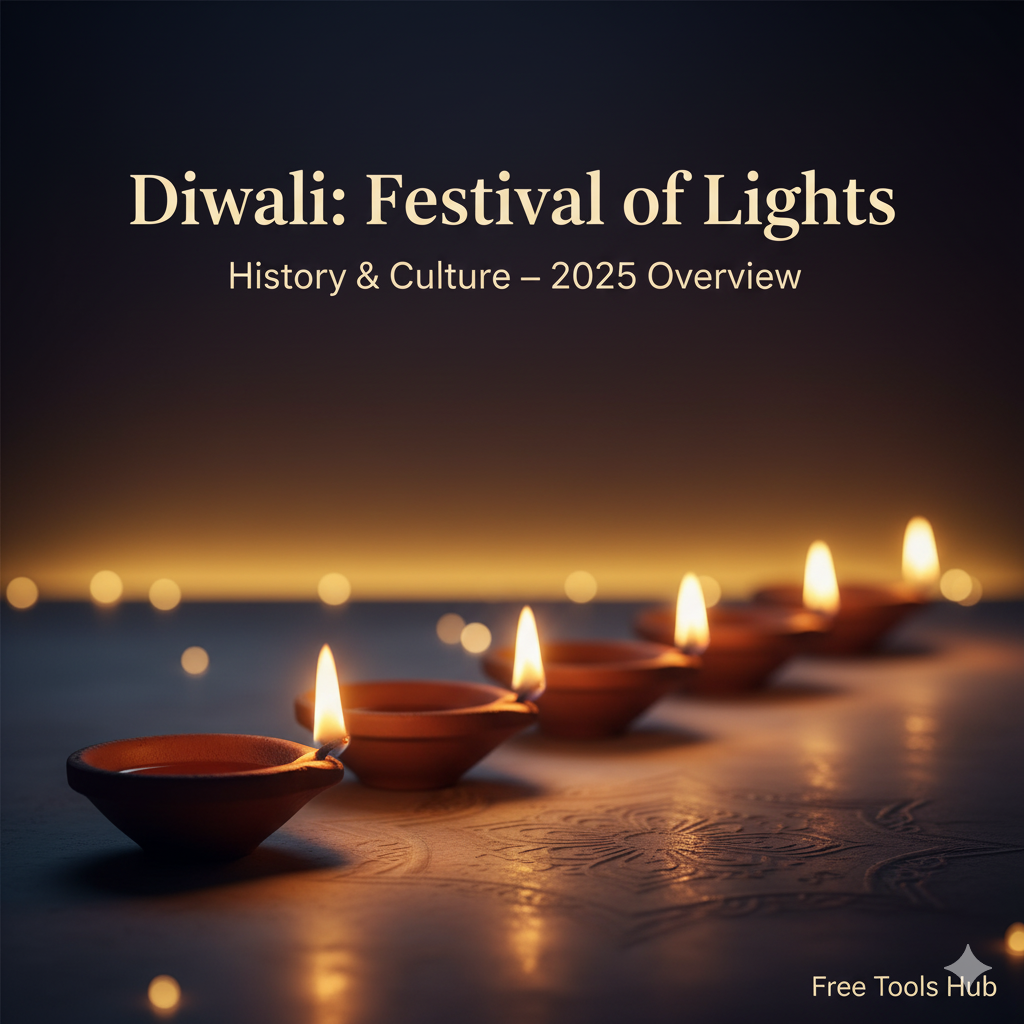Diwali: A Historical and Cultural Overview of the Festival of Lights (2025)
A research-style explainer tracing Diwali’s origins, historical evolution, multi-faith meanings, and regional diversity in India and the diaspora.

Diwali: A Historical & Cultural Overview of the “Festival of Lights”
Diwali (also “Deepavali,” from Sanskrit Deepavali, “a row of lamps”) is one of South Asia’s most widely celebrated festivals. It typically occurs in October/November, anchored to the lunisolar calendar—often aligning with the new-moon night of Kartika. Beyond a single narrative, Diwali encompasses layered histories and diverse meanings that vary by region and community.
Etymology & Early References
- Name: from deepa (lamp/light) + avali (row), i.e., rows of oil lamps (diyas).
- Antiquity: pre-modern literature mentions seasonal observances of light and harvest; the label “Deepavali/Diwali” later crystallized as a broad signifier for a religious-social celebration of light.
Multi-faith Meanings
Diwali carries distinct emphases across traditions:
- Hindu traditions: symbolic triumph of dharma over adharma; narratives include the homecoming of Rama and Sita (in Ramayana), worship of Lakshmi (prosperity), and regional Krishna-centered stories.
- Jainism: associated with Mahavira’s nirvana (spiritual liberation) in the 6th century BCE per Jain tradition.
- Sikhism: coincides with Bandi Chhor Divas (the release of captives) linked to the sixth Guru, Hargobind; gurdwaras are illuminated.
- Some Buddhist communities (e.g., Newar): observe light-themed days in the same season with cognate ideas of purity and renewal.
Brief Chronology
- Antiquity: agrarian cycles and early winter markers intertwine with light/harvest observances.
- Medieval era: household and urban customs of lighting, charity, and local storytelling consolidate.
- Modern era: Diwali becomes a pan-regional urban festival with a distinct seasonal economy (sweets, décor, gifting).
- Global diaspora: public-square celebrations, cultural showcases, and illuminated landmarks emerge worldwide.
Common Cultural Threads (Descriptive)
- Light: lamps/candles as emblems of purity, hope, and moral clarity; illuminated homes and marketplaces.
- Home & community: hospitality, visiting, gifting, and a premium on togetherness.
- Cuisine & sweets: seasonal confections and regional specialties.
- Commerce: festive retail cycles around jewelry, apparel, décor, and household goods.
Regional Variations
Names, narratives, and practices vary widely:
- Northern India: Rama-Sita homecoming and light-centric household customs.
- Western India: Lakshmi worship and business/accounting seasonality.
- Southern India: Krishna-centered or local mythic emphases; strong familial framing.
- Eastern India & Nepal: intersections with local seasonal arts and musical traditions.
- Diaspora: civic festivals, performances, and landmark illuminations.
Calendar Mechanics
Date determination relies on the lunisolar system, so the festival shifts relative to the Gregorian calendar. Many communities align Diwali with the new-moon night of Kartika, and several adjacent days are observed differently across regions—making Diwali more of a short “season” than a single fixed day.
Social & Economic Dimensions
- Seasonal spikes in décor, confectionery, fashion, jewelry, and household purchases.
- Charity and community service foreground values of generosity.
- Domestic and international travel to major city-level festivities.
Contemporary Representation
As Diwali globalizes, it is increasingly framed as a celebration of light, hope, and belonging; cities and institutions worldwide stage symbolic illuminations and cultural programs while communities maintain local specificity.
Conclusion
Rather than a single, uniform rite, Diwali is a broad religio-cultural canopy that gathers multiple narratives of light, renewal, and social cohesion—layered over centuries and refracted through regional histories.